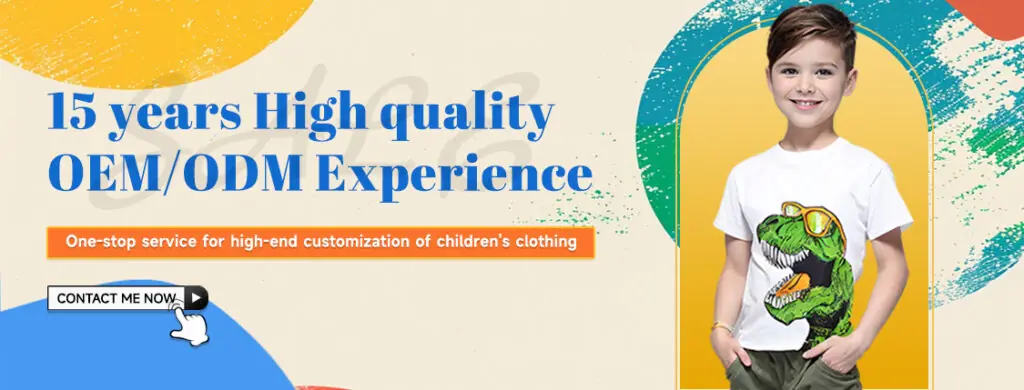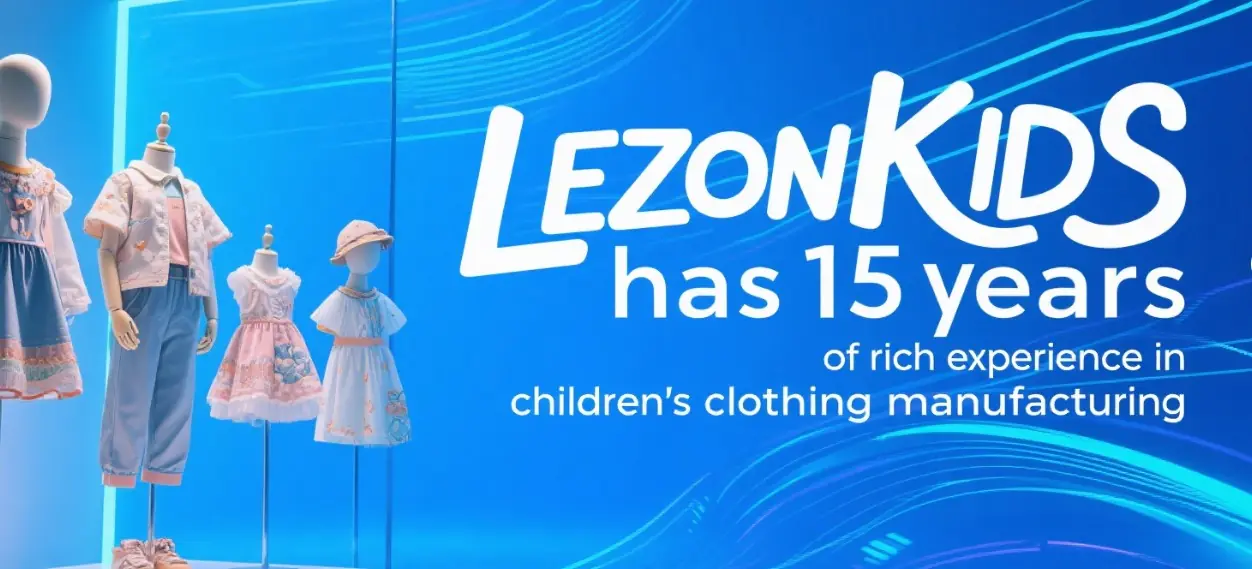In the current highly competitive children’s clothing market with severe homogenization, it has become a crucial move for retailers to explore paths for differential competition and build a unique brand matrix. This article will deeply analyze the full – process strategies from precise market positioning, innovative product development, strict supplier screening, to efficient IP co – branding operation and powerful supply chain empowerment, providing comprehensive guidance for retailers to create unique competitiveness.

Differential Positioning: Find Your Golden Track
Draw a Market Positioning Coordinate Map
The four – dimensional positioning analysis method can be used to accurately pinpoint the potential blue – ocean areas in the children’s clothing market.
- Horizontal Axis: Price Range (Low – end / Mid – end / Light Luxury)
- Vertical Axis: Style Type (Trendy / Classic / Themed)
- Third Dimension: Age Group (0 – 3 / 4 – 6 / 7 – 12)
- Fourth Dimension: Functional Scenario (Daily / Sports / Formal Wear)
For example, a regional brand precisely focuses on the “4 – 6 – year – old light luxury party wear” niche segment. With its unique positioning, the average customer price has soared to 2.3 times the industry average, and the repurchase rate is as high as 45%. It has successfully stood out in the competition and become a leader in the niche market.

Three Hidden Dimensions of Competitor Analysis
- Offline Store Layout Survey: Visit competitor stores in person and carefully observe the product combination and layout in their prime display areas. Analyze the display logic of products in different categories, styles, and price ranges to understand their display strategies for attracting consumers’ attention and guiding purchasing decisions, providing reference for optimizing your own store display and adjusting product combinations.
- Online Data Mining: Use professional tools to extract the TOP50 product review keywords of target stores. Precisely grasp consumers’ concerns, preferences, and pain points regarding products from their feedback, and identify unmet market demands to guide product improvement and new product development directions.
- Supply Chain Reverse Tracing: Trace the OEM factory based on the washing label information of competitors’ clothing, and deeply analyze their product development rules, including material selection preferences, process characteristics, and production cycles. Through in – depth insights into competitors’ supply chains, discover their advantages and weaknesses, providing references for optimizing your own supply chain and differential competition. According to a Nielsen retail report, in Q1 2023, the survival rate of new products in the industry was only 17%, while precise positioning can significantly increase the success rate to 39%, highlighting the crucial role of precise positioning in market competition.

Product Innovation Engine: From Process Breakthrough to Value Remodeling
The Fashion Formula of Sequins/Beads
Create unique selling points through the innovative combination of materials × processes × application scenarios:
- Material Revolution: Eco – friendly sequins have become a new trend. Made of eco – friendly and wash – resistant ribbon sequins, they not only maintain their color well and are not prone to fading but also conform to the concept of eco – friendly consumption, meeting parents’ dual concerns about their children’s wearing safety and environmental protection.
- Process Innovation:
- Three – Dimensional Relief Beadwork: Achieve a 3D effect through hot – pressing.
- Gradual Sequin Arrangement: Computer – aided design ensures a natural transition of light and shadow.
- Scenario Expansion: Apply evening – gown processes to daily – wear items. For example, decorate the pockets of jeans with beads, breaking the traditional boundaries of dressing scenarios and enhancing the fashion and uniqueness of daily clothing.
Case Reference: A brand’s “Starry Sky Series” using luminous sequins saw a 320% surge in nighttime search volume and had a 45% premium space.
Theme Series Development Calendar
- Q1: Christmas/Easter Series (Festival elements such as snowflakes, Christmas trees, reindeer + red and gold sequins)
- Q2: School Sports – themed Anniversary Co – branding (IP elements + laser – cut sequins)
- Q4: Frozen – themed (Gradual blue sequins + snowflake – shaped beads)
Note: Collaborating with suppliers that offer free design services can save at least 70% of the series development cost.

Supplier Screening: Unlock the Secrets of High – Quality Supply Chains
Design Capability Assessment Matrix
| Indicator | Weight | Assessment Method |
| Original Design Library Quantity | 25% | Ask suppliers to showcase outstanding design styles from the past two years and evaluate the richness and innovativeness of their design reserves. A rich and creative design library provides a broad source of inspiration for product development. |
| Process Realization Ability | 30% | Test samples of three complex processes provided by the supplier. |
| Trend Response Speed | 20% | Compare the time difference between their new products and those released at fashion weeks. |
| Customization Flexibility | 15% | Test the maximum number of times the design draft can be modified to examine the supplier’s ability to meet customers’ personalized requirements. High customization flexibility enables differential product customization to meet the unique market positions of different retailers. |
| Cost Control Ability | 10% | Obtain multi – material quotation plans for the same style and analyze the rationality of their cost structure. Seek the most cost – effective cooperation plan while ensuring quality to enhance product competitiveness and profit margins. |
During the assessment process, it is crucial to ask suppliers about the technical principle of sequin positioning. Qualified suppliers should be able to elaborate on technical details involving the precise layout of the CAD layout system and the accurate calibration of the laser positioning device to ensure that the pattern does not distort during production and the product design effect is perfectly presented.
7 – Element List for a Flexible Supply Chain
- Minimum Order Quantity ≤ 100 pieces: The low – minimum – order – quantity model effectively reduces retailers’ trial – and – error costs and inventory backlog risks, allowing them to test diverse products with a small capital investment, quickly respond to market changes, and flexibly adjust product portfolios.
- Sampling Cycle ≤ 3 working days: Fast sampling ensures that retailers can promptly verify the feasibility of design ideas, shortens the new – product development cycle, accelerates the product – to – market process, and seizes market opportunities.
- Mass Production Delivery ≤ 14 days: Efficient delivery capabilities ensure that products are available for sale on time, meeting the seasonal and time – sensitive characteristics of children’s clothing and avoiding missing the sales peak due to delayed delivery.
- Support for Mixed – Style and Mixed – Color Orders: This meets retailers’ diverse purchasing needs, facilitating the matching of different styles and color combinations, enriching store product displays, and enhancing the diversity of consumers’ purchase choices.
- Provide Intelligent Inventory Alerts: With the help of big data and information systems, monitor inventory dynamics in real – time, issue early warnings for inventory shortages or backlog risks, and assist retailers in making accurate replenishment and inventory management decisions.
- Have an Emergency Order Insertion Green Channel: Respond to sudden market demands or replenishment needs to ensure rapid production and supply in emergency situations, enhancing the supply chain’s emergency response capabilities and maintaining the continuity of customers’ sales.
- Defective Product Compensation Clause: Clearly define defective product handling specifications and compensation mechanisms to protect retailers’ rights and interests, urge suppliers to strictly control product quality, and reduce the probability of defective products entering the market.
McKinsey’s supply chain research shows that high – quality suppliers that meet all the above 7 conditions account for only 12% of the market, but collaborating with them can significantly reduce the unsalable risk by 38%, effectively enhancing retailers’ operating efficiency and market competitiveness.

IP Co – Branding Operation: Dual Levers of Traffic and Premium
Five – Step Method for Co – Branded Product Development
- IP Compatibility Test: Analyze the overlap of target customers’ interests through Google Trends.
- Legal Risk Assessment: Confirm that the authorization scope includes e – commerce channels and cross – border sales.
- Avoiding Design Red Lines:
- Do not change the facial feature proportions of characters.
- The main visual area ≤ 30% of the finished garment.
- Special Production Requirements:
- Use inks specified by the licensor (such as Pantone special colors).
- Have an independent production line to avoid material mixing.
- Marketing Mix Strategy:
- Limited – edition numbering to enhance scarcity.
- Incorporate AR scanning interactive functions.
Cost Estimation: Example of the Cost Structure for a Popular Anime Co – Branded Product
| Item | Proportion | Description |
| Authorization Fee | 15% | Paid in a stepped manner according to sales volume |
| Special Processes | 20% | Three – dimensional embroidery + laser – cut sequins |
| Marketing Expenses | 10% | Shared for joint promotion |
| Production Costs | 50% | Including exclusive quality inspection |
| Others | 5% | Logistics, insurance, etc. |
The Golden Rule for Pricing Co – Branded Products
- Basic Formula: Retail Price = (Production Cost × 2 + Authorization Fee) × 2.5
- Example:
- Production Cost: ¥50 per piece
- Authorization Fee: ¥10 per piece
- Calculation: (50×2 + 10)×2.5 = ¥275
The actual coefficient can be adjusted to 2.8 – 3.5 times according to the popularity of the IP.

Supply Chain Empowerment: The Ultimate Weapon for Creating Uniqueness
Small – Order Quick – Response Implementation Model
[Market Demand] → 7 – day Express Sampling → 50 – piece Test Order → Data Monitoring → 14 – day Bulk Replenishment
Benefit Comparison:
| Indicator | Traditional Model | Small – Order Quick – Response Model | Increase Rate |
| Trial – and – Error Cost | ¥30,000 | ¥6,000 | -80% |
| Inventory Turnover Rate | 2 times/year | 5 times/year | +150% |
| Best – Seller Hit Rate | 18% | 39% | +117% |
In – Depth Analysis of a Cooperation Case
A Maternity and infant chain brand achieved transformation through the following steps:
- Pain – Point Diagnosis: The original supplier had a minimum order quantity of 500 pieces, and the unsalable rate was as high as 35%.
- Solution Implementation:
- Adopt a 50 – piece minimum order quantity to test 12 new styles.
- Leverage the supplier’s free design to develop 3 theme series.
- Activate the 7 – day quick – response channel to replenish best – selling products.
- Result Data:
- Trial – sale costs were reduced by ¥210,000 per year.
- Sales increased by 67% year – on – year.
- The member repurchase rate increased to 58%.

The Underlying Logic of Uniqueness
Brand Uniqueness = (Precise Insights × Innovative Design) / Supply Chain Flexibility
By choosing HAPA, you will get:
✅ Support from a design library of over 2000 designs for rapid idea implementation
✅ A flexible 50 – piece minimum order quantity to test the market
✅ Access to IP co – branding resources to capture traffic highs
✅ 14 – day delivery to seize the sales window
Take action now and claim the “2025 Trendy Children’s Clothing Trend Handbook”, which covers 12 cutting – edge innovative solutions such as the latest sequin iridescent process and intelligent bead – setting technology, helping you make precise layouts in the children’s clothing market, create best – selling series, and start a glorious chapter for your brand.





